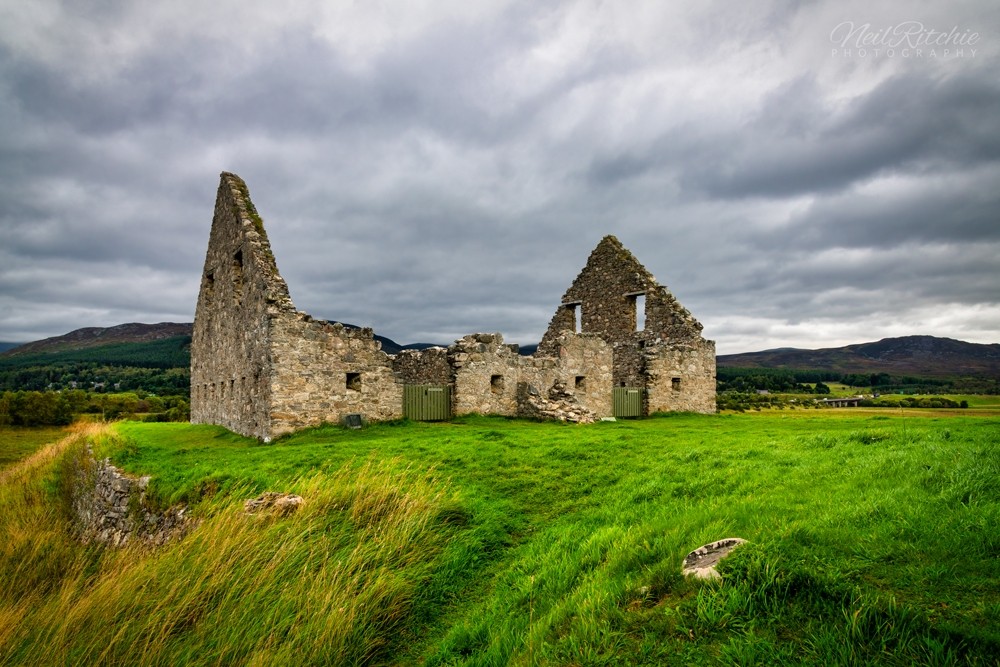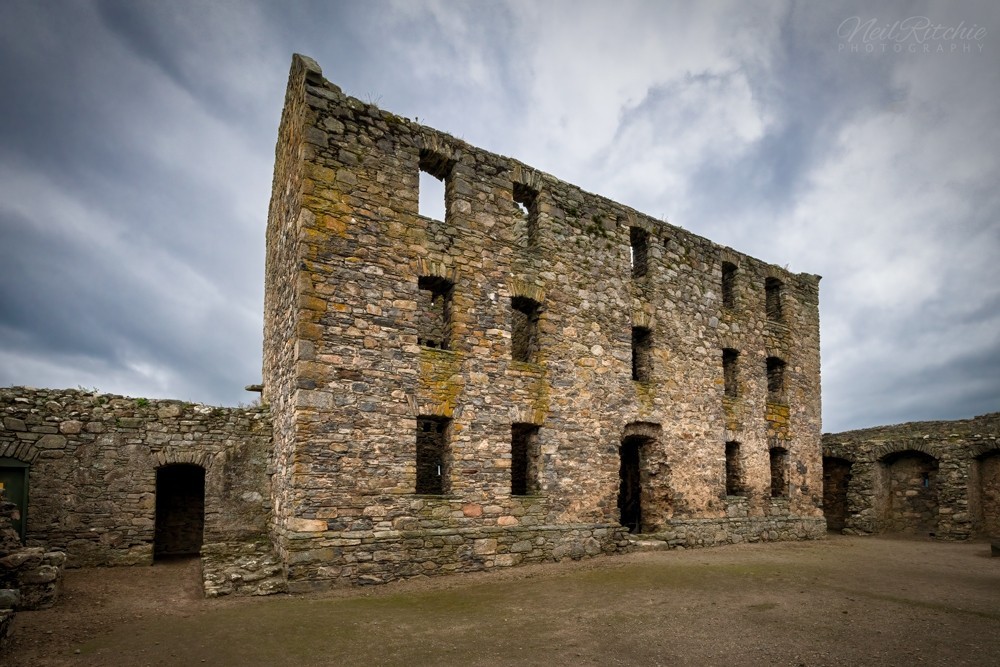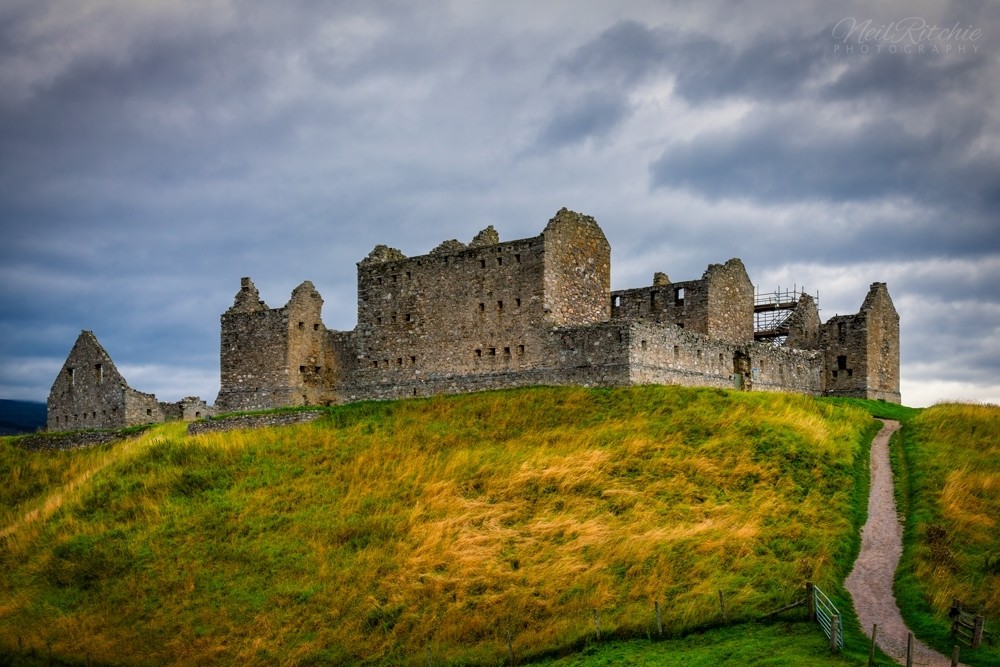Situated on the south side of the River Spey overlooking the small town of Kingussie in Badenoch, Ruthven Barracks was one of four highland barracks that were constructed following the Jacobite Rising of 1715. During the Jacobite Rising of 1745, the barracks came under attack by the Jacobites twice and it was where the Jacobite army received orders to disband following the defeat at Culloden.
At the onset of the Jacobite rising in August 1745, Lieutenant-General Sir John Cope, commander-in-chief for Scotland, marched a government army of over 1,500 men into the highlands, determined to nip the rebellion in the bud before it could pose any serious threat.
Marching his force from Stirling on 20th August, he intended to march to Fort Augustus by way of General Wade’s military roads, arm the pro-government clans, contain and subdue the Jacobites, and apprehend Charles Edward Stuart.1
On approaching Corrieyairack Pass, ten miles from Fort Augustus, Cope was informed that the Jacobites were lying in wait for him. Not wanting to risk forcing the Pass, Cope withdrew and marched to Ruthven Barracks, arriving there on the 27th. Cope’s plan now was to march to Inverness and raise the main loyalist clans of the Grants, Munros, and Mackays.
Leaving Ruthven Barracks on the 28th, Cope left behind Irishman Sergeant Terrence Molloy, with a corporal and twelve privates of Lee’s 55th Regiment as a garrison.
Instead of following Cope the Jacobites decided to move towards Blair Castle, the seat of the duke of Atholl, and raise men from his estates. Jacobite Major-General John Gordon of Glenbucket later recounted:
It was determined the next day, yt the Prince wou’d not follow Cope, but wou’d make the best of his way to Blair, to raise the Athol men. The day the Prince was to decamp, Sullivan parted as usual to reconnoitre the Camp, & prepare the Prince’s quarters, with Lochgarry & some other officers and about thirty men; John Murray was sent in all diligence after him with orders to take the road of Revin, where he’d meet with Archy Cameron, & attack those Barracks, where there was only a sergeant & sixteen men.
Sullivan cou’d not but obey, but represented the difficulty of it, & yt there were no Barracks, without being surrounded by walls & flanked, but one Gordon who was of yt neighbourhood, & was the man yt gave the project, assured it was an open house only.
Sullivan parted & met with Mr. Cameron about three mils from Reven, continued his march as near as he cou’d to the Barracks without being discover’d; he clad himself there inhighland cloaths, & went to reconnoitre, found this open house to be two buildings upon a sugar loaf, joyned together by a very high rampart with a parapet, wch formed a Square & flanked at every corner; there were stables detached from the barracks & surrounded by a wall breast high, & the ramp inaccessible in a manner.2

Situated on the south side of the River Spey near the small town of Kingussie in Badenoch, Ruthven Barracks was constructed between 1718 and 1721 on the site of an earlier medieval fortification.
Designed by the architect James Smith, Ruthven was one of four barracks commissioned by the government of George I following the Jacobite rising of 1715. From these bases, government troops could police the surrounding countryside and enforce the Disarming Acts of 1716 and 1725.
Ruthven Barracks comprised of two three-story accommodation blocks that could house sixty men each and was surrounded by an enclosure wall with musket loops. In 1734, at the recommendation of General Wade, a guardhouse was added and a stable for thirty dragoons built, of which the attic floor was used to store hay for the horses. A postern gate was inserted in the west wall of the barracks to give access to the stable block.
The dragoons were ‘to serve as a convoy for money or provisions for the use of the Forces as well as to retain that part of the country in obedience’. The dragoons would patrol along the military roads built by General Wade in the 1720s and 1730s. Wade’s road network was built to link the new barracks and highland forts with the lowlands and to facilitate the movement of government troops, to make the Scottish Highlands more accessible.

On 29 August, on the orders of Major-General John Gordon of Glenbucket, 150 Camerons led by Colonel John O’Sullivan and Archibald Cameron moved to secure the barracks. Glenbucket believed the barracks held arms and supplies and would be undefended after Cope’s departure.
O’Sullivan, an Irish professional soldier, had misgivings about the plan, especially as the Jacobite force lacked artillery. He went forward to investigate the barracks and on realising that they were garrisoned, quickly planned a two-pronged assault. He would lead one party to plant a barrel filled with flammable material against the door linking the main block to the stables, while another party, using the fire as a distraction, would scale the wall with ladders and take the garrison by surprise.
Using the stable block as cover, Sullivan’s party reached the door and set the barrel alight. The door was at the top of three stairs and as they tried to position the flaming barrel next to it the garrison opened fire on them, inflicting casualties. The other party was unable to position their ladders next to the walls and the Jacobites broke off the attack. Late in the evening, Molloy allowed the Jacobites to carry off their dead and wounded. He had lost one soldier who had been shot through the head after sticking it above the parapet.
The following day Molloy wrote to Cope giving his account of the event:
Ruthven Redoubt, August 30th 1745
Honourable General, This goes to acquaint you, that Yesterday there apeared in the little Town of Ruthven above 300 Men of the Enemy, and sent Proposals to me to surrender this Redoubt, upon Condition that I should have Liberty to carry off Bag and Baggage. My answer was, that I was too old a Soldier to surrender a Garison of such strength. without bloody Noses. They threatened hanging me and my Men for Refusal. I told them I would take my Chance.
This Morning they attacked me about twelve o’Clock, by my Information with about 150 Men: They attacked Fore-Gate and Sally-Port, and attempted to set the Sally-Port on Fire, with some old Barrels and other Combustibles, which took Blaze immediately; but the Attempter lost his life by it. They drew off about half an Hour after Three.
About two Hours after they sent to me, that two of their Chiefs wanted to talk with me. I admitted and spoke to them from the Parapet. They offered Conditions: I refused. They desired Liberty to carry off their Dead men; I granted. There are two Men since dead of their Wounds in the Town and three more they took with them wounded as I am informed. They went off Westward, about eight o’clock this Morning.
They did the like March Yesterday in the Afternoon, but came back at Night fall. They took all the Provisions the poor Inhabitants had in the Town; and Mrs McPherson, the Barrack-Wife and a Merchant of the Town who spoke to me this Moment, and who Advised me to write to your Honour: And told me there were above 3000 Men all lodged in the Cornfields West of the Town last Night, and their grand Camp is at Dalwhinny: They have Cluny McPherson with them Prisoner, as I have it by the same Information.
I lost one Man shot through the Head by foolishly holding his Head too high over the Parapet, contrary to orders. I prevented the Sally-Port taking Fire by pouring Water over the Parapet. I expect another Visit this Night, I am informed, with their Pateraroes [swivel guns] but I shall give them the warmest Reception my weak, Party can afford. I shall hold out as long as possible. I conclude, Honourable General, with great Respect.
Your most obedient and humble Servant.
MOLLOY, Sergeant3
Cope forwarded the letter to the Secretary of State for Scotland John Hay, 4th Marquis of Tweeddale, with the recommendation that Molloy should be ‘made an Officer for his gallant behaviour’. Sergeant Molloy was promoted to the rank of lieutenant, with the Commission Registers recording the promotion on 12th September 1745.
On 10th February 1746, a larger Jacobite force, this time equipped with artillery, attacked the barracks. Major-General John Gordon of Glenbucket wrote the following note to Molloy who was still in command:
There are by his R.H. Order. I send you this to desire you will surrender, without Loss of Time, to give up the Barrack, and so render yourselves Prisoners at Discretion; or these are to certify, you are to expect no Mercy. GORDON.4
Molloy replied to Glenbucket’s demands for surrender:
Sir, I don’t see but I am in a Condition to make a good Defence in my Garrison. Still I know I cannot stand a long regular Siege, especially against Cannon; yet I am resolved to the last Extremity, in every respect, to sustain the Character of a Gentleman, and to answer the Expectation and Confidence of my Royal Master, with Regard to what he has committed to my Trust. To be brief, I will not surrender until your Prince’s Approach to this place, and then upon the following Conditions only; 1st. That my Men and I be humanely treated, as I am inform’d of the Revenge and Threats denounced against us by the Clans who attacked this Garrison last August. 2nd, That we shall not be rifled or pillaged; and that your Prince grant me my Parole of Honour, and set my men at Liberty as he has done other Prisoners hitherto, considering the Difference betwix Prisoners of this Kind, and those taken in the Field of Battle – Gen. Gordon, an experienced humane Officer, can’t deny this reasonable Intreaty; and upon Preformance thereof, I will deliver the Keys of the Garrison to your Prince, and upon giving a Guarantee to fulfill the above Conditions. Further I permit Gen. Gordon to send his Horses and Grooms to my Stables this night, without Arms: All I require for my Honour and Security on this Head, is, that Col. Grant may be permitted to stay as a Hostage in my House until the Prince’s Arrival.
MOLLOY.5
Knowing that he would not be able to withstand an artillery bombardment Molloy surrendered to the Jacobites the following day and he and his men were released and allowed safe passage to Perth.

Following the Jacobite defeat at the Battle of Culloden in April 1746, the remnants of the Jacobite army assembled at Ruthven Barracks with the intention of continuing the campaign. It was here that they received the final order from Charles Edward Stuart: “Let every man seek his own safety in the best way he can”.
In his Memoirs of the Rebellion in 1745 and 1746, James Johnstone recalls the gathering at Ruthven following the battle of Culloden:
I arrived, on the 18th, at Ruthven, which happened, by chance, to become the rallying point of our army, without having been previously fixed on. There I found the Duke of Athol, Lord George Murray, the Duke of Perth, Lord John Drummond, Lord Ogilvie, and many other chiefs of clans, with about four or five thousand Highlanders, all in the best possible dispositions for renewing hostilities and taking their revenge.
The little town of Ruthven is about eight leagues from Inverness, by a road through the mountains, very narrow, full of tremendously high precipices, where there are several passes which a hundred men could defend against ten thousand, by merely rolling down rocks from the summit of the mountains.
Lord George immediately dispatched people to guard the passes, and at the same time sent off an aide-de-camp to inform the Prince, that a great part of his army was assembled at Ruthven; that the Highlanders were full of animation and ardour, and eager to be led against the enemy; that the Grants, and other Highland clans, who had, till then, remained neuter, were disposed to declare themselves in his favour, seeing the inevitable destruction of their country from the proximity of the victorious army of the Duke of Cumberland; that all the clans, who had received leave of absence, would assemble there in the course of a few days; and that, instead of five or six thousand men, the whole of the number present at the battle of Culloden, from the absence of those who had returned to their homes and of those who had left the army on reaching Culloden, on the morning of the 16th, to go to sleep, he might count upon eight or nine thousand men at least, a greater number than he had had at any time in his army. Every body earnestly intreated the Prince to come immediately, and put himself at the head of this force.
We passed the 19th at Ruthven, without any news from the Prince. All the Highlanders were cheerful, and full of spirits to a degree perhaps never before witnessed in an army so recently beaten, expecting, with impatience, every moment the arrival of the Prince; but, on the 20th, Mr. Macleod, Lord George’s aide-de-camp, who had been sent to him, returned with the following laconic answer ; — “Let every man seek his safety in the best way he can:” – an inconsiderate answer, heart-breaking to the brave men who had sacrificed themselves for him.6
Notes:
- Report of the proceedings and opinion of the Board of General Officers, on their examination into the conduct, behaviour, and proceedings of Lieutenant-General Sir John Cope
- John William O’Sullivan, 1745 and After: An Account of the Jacobite Rebellion of 1745
- Report of the proceedings and opinion of the Board of General Officers
- The Newcastle Gazette, 1746
- Ibid.
- James Johnstone, Memoirs of the Rebellion in 1745 and 1746
Further Reading:
Christopher Duffy, Fight for a Throne: The Jacobite ’45 Reconsidered, (Helion and Company, 2015)
Victoria Henshaw, Scotland and the British Army, 1700-1750, (Bloomsbury Publishing, 2015)
Stuart Reid, 1745: A Military History of the Last Jacobite Rising, (The History Press Ltd, 2000)


